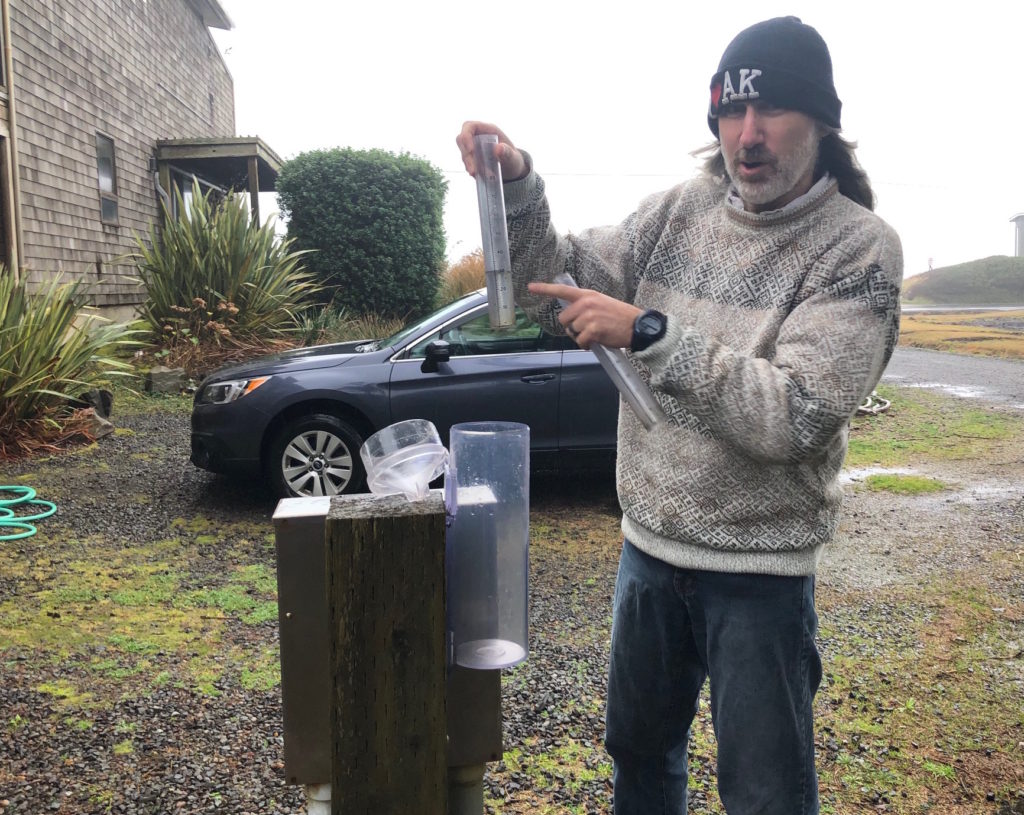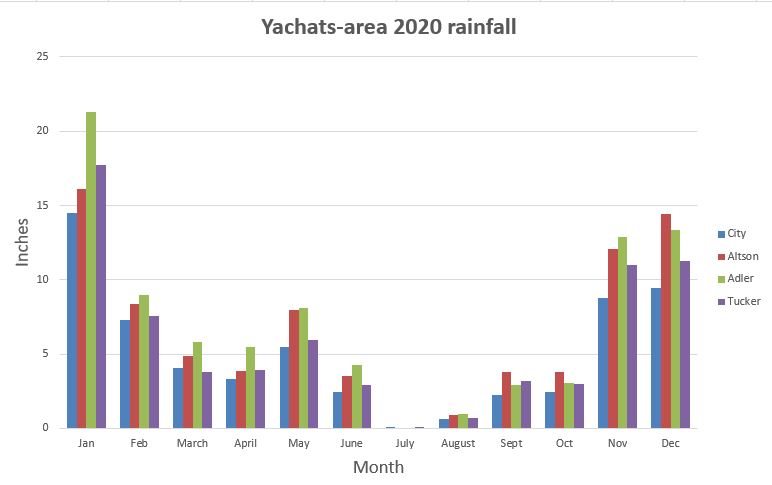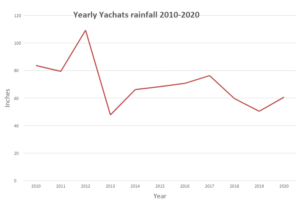
By QUINTON SMITH/YachatsNews.com
It’s a good thing that Adam Altson is a morning person.
Every day at 7 a.m. the Yachats resident goes out to measure rainfall for the last 24 hours, checking a long plastic tube inside a gauge at his house on Ocean View Drive. He enters the number in his own spreadsheet and then logs onto a national network to let anyone who’s interested know how much it rained in Yachats.
“I’ve always had an interest in weather,” the retired software developer says who moved full-time to Yachats in 2017. “… it’s interesting to see what really happened when something moves through here.”
Altson is not alone.
There’s a lot of weather gauges around the Yachats area because, well, the central Oregon coast gets a lot of weather.
Jim Adler, a conservation advocate who lives three miles up the Yachats River, began tracking rainfall nearly 20 years ago. He’s lived 45 years on 10 acres and his gauge is near Reedy and Salmon creeks, the two sources of the city’s drinking water.
“All these people who do this … we all talk about it with each other,” Adler said.

Location, location, location
So, when wrapping up the local weather for the 2020 calendar year, it’s always good to check in with people like Altson, Adler and others to see what their instruments say.
The city of Yachats also operates an automatic weather station at its wastewater treatment plant – one that for the past two years YachatsNews has treated as the “official” rain gauge for the city.
But when it comes to rain at the coast, not much is official. For just like real estate, weather is affected by location, location, location.
And, there are the peculiarities of many automated stations, which can suffer breakdowns, outages and clogs affecting their measurements. Manual gauges – if properly and regularly checked – are considered more accurate than automated stations.

For example, the city’s automated weather station measured 9.43 inches of rain in December and 60.67 inches for all of 2020. Altson lives within a block of that device and manually measured 13.33 inches in December and 87.10 for the year.
Lance Bloch, a Yachats Planning Commission member who has a manual gauge at his home on Aqua Vista Loop, measured 10.18 inches of rain in December and 64.27 inches for 2020.
Donald Tucker, chair of the Southwest Lincoln Water PUD, lives two miles north of Yachats on the east side of U.S. Highway 101. A longtime weather watcher, Tucker measured 11.27 inches of rain in December and 70.43 for the year – nearly 10 inches more than the city of Yachats’ gauge.
Adler has an automated gauge, but because it is farther east in the foothills of the Coast Range. He measured 13.33 inches of rain in December and 87.10 for the year.
Adler says he doesn’t fret too much about the differences between gauges and places. It’s more important to track weather and rain with one gauge over time.
“That’s because the rain is all over the place,” he said. “Oftentimes the numbers are different 100 feet away.”
Dave Buckwald, who oversees the city’s wastewater treatment plant and monitors the city’s rain gauge, heartily agrees.
“There are all these micro weather systems in Yachats,” said Buckwald, recounting one recent storm when it rained so hard in one area he had to stop driving, only to go to another section of town where there was just a mist falling.
By all measurements, however, 2020 was a drier than average year – despite heavy rainfall in January, November and December.
The average rainfall over the last 11 years measured by the city of Yachats is 73.48 inches. The amount measured by the city in 2020 was 60.67 inches — 13 inches below that.
At Adler’s upriver gauge, the 11-year average is 90.9 inches. But his 2020 total was just three inches below that.
Timing is everything
There are other elements to Yachats’ weather, of course, including wind and temperature. Since 2014, Altson has kept track of those as well.
He can tell you that 2020 was the windiest year since 2017, with 80 days of winds higher than 30 mph. And, 30 of those days had gusts greater than 40 mph.
By comparison, 2019 had 56 days with wind gusts of more than 30 mph, according to Altson’s gauge.
So what are people like Altson seeing in Yachats’ weather?
Compared with 10 years ago, there is still a lot of rain but a trend to have slightly less of it.
There seems to be a few more days above 70 degrees, Alston said, while warning “that it’s not safe to generalize” over such a short time period.
And it seems to be getting windier, with three of the last four years having more than 78 days of winds greater than 30 mph.
Adler’s interest in rain is related to stream flows in the Yachats River, going back years when he was part of a local water monitoring group for the Oregon Department of Environmental Quality.
He’s still trying to determine the effects of rain volume and timing on stream flow, especially as it relates to the critical low-water month of October when salmon begin to return.
Adler’s theory is that good rains in May and June generally mean good river flows in October. By late spring, he said, the forest “sponge” is generally full of water and slowly begins releasing it through the summer.
“It’s not necessarily the amount of rainfall we get in a year, but the timing of that rainfall,” he said.



